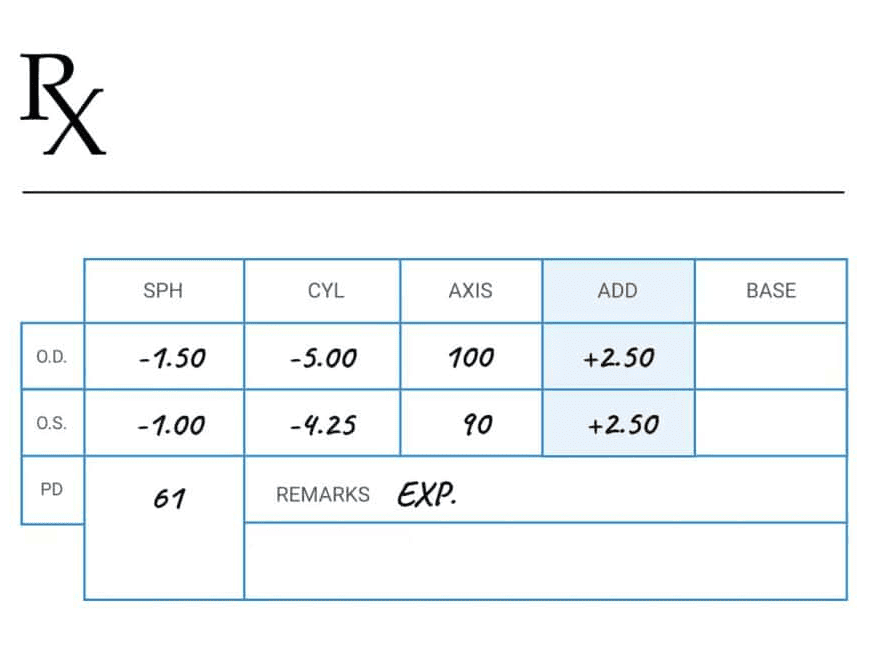Reading your eyeglass prescription can seem confusing at first, but it’s actually quite simple once you understand the terms. Let’s not waste any time and get right into it.
Basic Components of an Eyeglass Prescription
- OD and OS:
- These are abbreviations originating from Latin terms. OD (Oculus Dexter) refers to your right eye, and OS (Oculus Sinister) to your left eye. Sometimes, you might see OU, which means something involving both eyes.
- Sphere (SPH):
- This number indicates the strength of the lens needed to correct your vision. It’s measured in units called diopters. If the number has a minus (-) sign, it means you’re nearsighted (you see close objects clearly but struggle with distant objects). A plus (+) sign indicates farsightedness (you see distant objects more clearly than close ones).
- Cylinder (CYL):
- This number shows if you have astigmatism (where the eye is shaped more like a football than a perfect sphere, causing blurred vision). If there’s no number, you probably don’t have significant astigmatism. Like SPH, CYL values are in diopters. The number could have either a plus or minus sign.
- Axis:
- If you have a CYL number, you’ll also have an Axis value, which ranges between 0 and 180 degrees. This tells the lens maker the angle at which to position the astigmatism correction in your lenses.
- Add:
- This is relevant if you need bifocals or progressive lenses (which help with reading or seeing things up close). It’s the additional magnifying power added to the bottom part of multifocal lenses. This number is always a plus and usually ranges from +0.75 to +3.00.
- Prism:
- This is less common and is used to correct alignment problems in the eyes. It’s measured in prism diopters (a unit that describes the displacement of the image seen through the lens) and indicates the direction the prism in the lens needs to redirect the light.
- Base:
- This is related to prism correction, which is less commonly required. It indicates the direction in which the prism in the lens should be oriented. This is important for individuals who need their lenses to adjust the light path to correct eye alignment issues. The “Base” direction is typically noted as up, down, in (towards the nose), or out (towards the ear), ensuring accurate placement of the prism for effective vision correction.
Additional Terms You Might Encounter
- Pupillary Distance (PD):
- This is the distance in millimeters between the centers of the pupils of your eyes. This is used to correctly align the optical center (where you can see the clearest) of your lenses with your eyes.
- Segment Height (Seg Height):
- This is important for bifocal, trifocal or progressive lenses. It tells the lens lab where to position the different optical zones of your bifocal, trifocal or progressive lenses.
Tips for Reading Your Prescription
- Start with One Eye: Focus on understanding the prescription for one eye first (OD or OS), then move to the other.
- Identify Your Correction Type: Check the SPH value to know if you’re nearsighted or farsighted. Then, look at CYL and Axis to see if you have astigmatism.
- Multifocal Lenses: If you have an Add value, you’re looking at a prescription for multifocal lenses.
- Clarify Doubts: If anything seems confusing, ask your eye care professional to explain. It’s important that you understand what each part of your prescription means.
As long as your local optician keeps a record of your prescription, or you have a physical copy to bring with you the next time you’re shopping for glasses, you don’t need to know all of the details of your prescription. If you’re still confused, remember that there’s no harm in asking questions – your local optician is there to help you.
Discover independent eyewear with Project Spex. Every Friday, we deliver the latest in collectible eyewear and your favorite independent designers.
Sign up now and never miss a thing!
About The Author:

Will Benjamin is an advocate for independent eyewear and one of the driving forces behind Project Spex. With a passion for unique, collectible, and limited-edition eyewear, Will aims to inspire people to build their own collections through Project Spex, while supporting the success of independent opticals.


